Human decisions are
made by a partly conscious but largely unconscious process. Information
entering the brain from the senses, and information stored in memory,
interact with that person’s deeply held beliefs and values. Computer
data processing is a useful analogy. The evolution-designed human brain
is the hardware. The person’s internalized values and beliefs are the
program. The person’s senses and memories provide the information that
is processed. The result of that processing is behavior — a decision
to do this, that, or perhaps nothing. The details are extremely complex
and not completely understood, but the diagram below conveys the basic
idea.
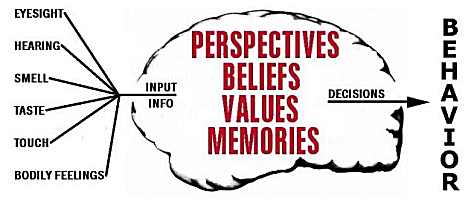
From
this we can see that there are several places where things can go wrong:
brain structure and functioning, the values, the beliefs, one’s memories,
and the incoming sensory information. Let us begin with the brain.
Problems Rooted
in Brain Design
The human brain actually
consists of three brains nested within each other, each having been developed
during a different evolutionary period.
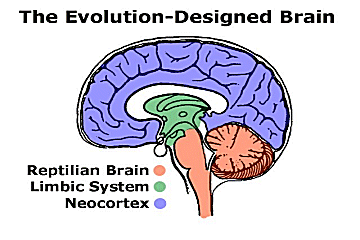
The innermost brain,
sometimes called the brain stem or the reptilian brain, is located
at the top of the spinal column and is the primitive core of the human
brain. Designed by evolution to guide the behavior of reptiles, it is
the most ancient of the three. It consists of the medulla oblongata,
the pons, and the reticular formation. In humans, it controls
basic bodily functions, such as heartbeat, breathing, swallowing, sneezing,
and blood pressure. During sleep, the reticular formation monitors sensory
data and arouses the rest of the brain when it detects something it deems
dangerous such as an unfamiliar noise or skin sensation.
The limbic system
(consisting of thalamus, fornix, hippocampus, hypothalamus,
and amygdala) is an add-on brain that evolved to help mammals survive
and reproduce. Wrapped around the brain stem, it is the seat of human
emotions — strong reactive emotions, such as fear, lust, anger, and jealousy,
as well as subtler emotions, such as maternal feelings and those that
define moods. The limbic system also plays a major role in memory.
Mammals also have
a third brain: a neocortex, located atop and around the limbic
system. Relative to body size, cats have a small cortex, chimpanzees have
one of medium size, and humans have a very large one. The human neocortex
is the thinking brain, the seat of many higher-level functions, such as
speech, planning, decision-making, visualization, and the intellectual
control of a person’s emotional life. The three nested brains are interconnected
in complex ways, and recent neurological and psychological research has
revealed much about how the whole integrated system works.
This evolution designed
brain/mind system creates for each person a mental model of reality that
contains some serious distortions and outright lies. In the difficult
circumstances of primitive living, some of these lies actually helped
people to survive. In present circumstances, however, they often cause
serious problems.
Reactive Emotions
— Reactive emotions and emotion-driven actions helped early humans
to survive and reproduce in primitive circumstances. Today, however, strong
human emotions distort a person’s sense of relative importance and often
lead to inappropriate behavior. It works like this:
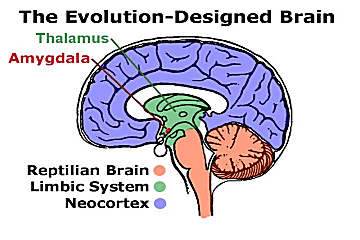
The thalamus acts
as a relay station for raw sensory input data. It sends this data both
to the neocortex for detailed (but relatively slow) processing and directly
to the amygdala, where it is evaluated in a crude but more immediate way.
The amygdala monitors all the sensory data passing through the thalamus
for threats to the person. If its hardwired programming detects a danger
of some sort, it puts the brain in crisis mode.
Some of these crisis
messages cause physical things to happen, such as the release of fight-or-flight
hormones, the tightening of muscles, and the release of brain chemicals
that heighten alertness. At the same time, a feeling is presented
to consciousness — say, of fear, anger, hatred, greed, or jealousy — as
determined by the amygdala’s rough-and-ready analysis of the sensory data.
Sometimes, a powerful emotion leads to immediate action. The person acts
before the more comprehensive and sophisticated, but slower, cortical
evaluation process has been completed. At times, this kind of immediate,
reactive behavior might save an endangered life; at other times, it results
in great harm and profound regret. A mark of emotional intelligence, development,
and maturity is the ability to delay acting until the cooled–out second
opinion from the frontal lobes of the cortex has reached consciousness.
Unfortunately, some people treat emotions as action imperatives and react
on impulse in situation after situation. They have not learned that emotional
feelings are simply messages from the limbic brain to the conscious mind,
to be ignored or acted upon as other brain processes (intellect and intuition)
dictate.
Fear, in particular,
is highly controlling and difficult to deal with. It was a helpful motivator
when vision detected an approaching tiger, and in that situation immediate
action made perfect sense. But in today’s very different world, the experience
of fear often leads to inappropriate behavior — or immobilizes people,
preventing appropriate action. Unfortunately, human beings are not good
at assessing risk. The deaths of 3000 people in the terrorist attacks
of September 11, 2001 triggered an immobilizing wave of fear that swept
across America. The fact that a dozen times that many deaths occur each
year in automobile accidents does not. That said, humans are fear-prone
beings, and fear is often used as a mechanism of control. The media carry
stories that create fear, and the size of their audience increases. Political
regimes exaggerate risk, demonize an enemy, and use other fear-provoking
techniques to get people to agree with the regime’s program of action.
The emotional vulnerability of human beings — a combination of fear, confusion,
and the hope of relief from fear — allowed the George W. Bush administration
to implement an agenda that greatly increased Executive power, reduced
civil liberties, and killed many more civilians in Afghanistan and Iraq
than were killed in the September 11 attacks.
Personhood and
Identity — We have also been misled about personhood and identity.
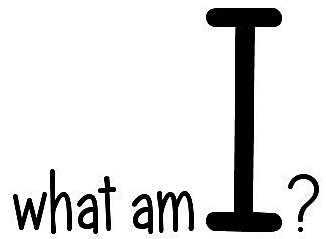
We have a primal
sense of existing, a self-sense, an I AM feeling. And almost all of us
associate that feeling with body and mind contents. This makes sense from
an evolutionary perspective. The human brain evolved during an extended
period when our ancestors relied on hunting and gathering for survival.
When under threat in primitive circumstances, the illusion of being an
independent person increased the likelihood of personal and species survival.
So it made evolutionary sense to consider oneself an independent person.
In reality, however, humans are not separate independent beings; they
are nodes of universal process.
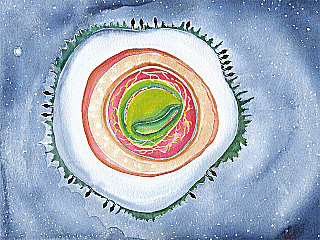
They utilize the
sun’s energy, exchange gases via the atmosphere, take in nutritious chemicals,
produce wastes, and are linked in numerous ways to other beings and systems.
More fundamental
still, persons are simply informational modulations of the primal carrier:
Being, Spirit, Energy-Awareness.
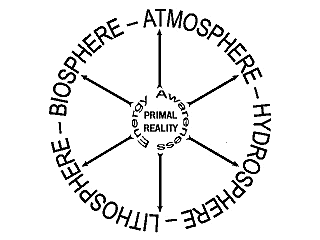
Think of the ocean
and its waves. Waves are ocean's informational modulations, having form
and activity. Yet from another perspective, waves are simply ocean. Like
the ocean and its waves, humanity — and all of existence — is
the primal ONE in countless forms. Unfortunately, human reliance on vision
constantly reinforces the illusion of separateness. People appear to
be isolated entities. But they are not.
One side effect of
our distorted sense of identity is the limited sphere of concern that
we all start out with, and that we transcend only with difficulty.
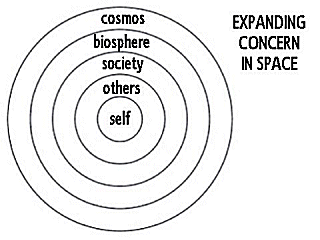
Our built-in tendency
is to be concerned primarily about our own immediate situation —
ourselves, our family, our friends — those physically close to us,
and close in relationship. Yet the expansion of concern about the well-being
of others is possible, and is a characteristic of developing wisdom.
The same is also
true about the extension of concern in the realm of time.
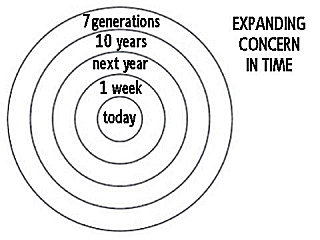
We tend to be concerned
about the near term — about having things go well now and in the
immediate future. Again, concern about well-being in the more distant
future is possible, and it develops as one grows in wisdom.
Mental Blind Spots
— Human beings lie to themselves in a variety of ways. Psychologists
use the terms denial, rationalization, projection, and repression to identify
various forms of the phenomenon. Whatever the mechanism, the result is
a mental blind spot. The individual fails to see some truth about him
or her self. Similarly, human cultures and entire nation-states have
blind spots concerning historical realities and current practices that
they would rather not acknowledge.
Other Distortions
of Reality —
-
People find it
difficult to internalize the reality of their own eventual death.
-
They have difficulty
conceptualizing magnitudes that are vastly different from those they
deal with in everyday life. They can’t intuitively grasp the very
large or the very small.
-
They notice sudden
changes, but not gradual changes.
-
Humans tend to
oversimplify causation. They pick out some dominant element in a situation
and call it “The Cause,” when in fact there are myriad necessary elements
— an entire causal matrix — with roots that go back to the origin
of the universe.
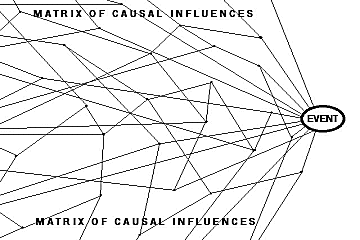
Belief and
Value Problems
Each human’s inner
life and outer behavior is the joint product of nature and nurture: genes
on the one hand and life experience on the other. Each person arrives
on Earth with a set of genetically determined potentials, some of which
are common to all and some of which differ from person to person. All
babies drink, cry, sleep, and wet their diapers. But some babies sleep
their first month away while others cry it away. Some startle easily;
some don’t. Some are exceptionally alert and attentive; others are less
so. Some have a generally rejecting attitude, others a generally accepting
one. In addition to these built–in attitudes and tendencies, each baby
is born with a very wide range of undeveloped potentials. These include
intellectual potentials, physical potentials, musical potentials, artistic
potentials, potentials for generosity and caring, potentials for selfishness
and mean-spiritedness, etc.
On the nurture side,
it is society’s job to take this raw malleable humanness, this watchful,
willful, bundle of potentials, and develop some of them into functioning
actualities. If one set of potentials gets developed, you get one kind
of person and one expression of “human nature.” When another set develops,
you get a different person and a different human nature. It is the matrix
of influences in each person’s life that determines which innate
potentials develop into actualities and which do not.
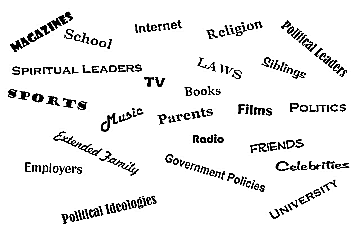
These influences
arise from involvement with parenting, schooling, the legal system, religion,
employment, organizations, the electronic and print media, and people
in general. Societies need individuals who accept the overall goals,
values, and ethical standards of their society and are willing to contribute
to the well-being of the society’s major institutions. This is accomplished
by influencing people to develop a compatible set of beliefs and values.
Internalized beliefs
are deeply-held assumptions about what is true and real. Some beliefs
reflect objective reality; others do not. But true or false, beliefs
play a key role in directing behavior. Each person has a great many beliefs,
and these come together as a pattern of beliefs about the world, a picture
of how things are, a personal worldview. Sometimes it is a single
belief that is involved in making a decision. Often it is a cluster of
beliefs extracted from that worldview.
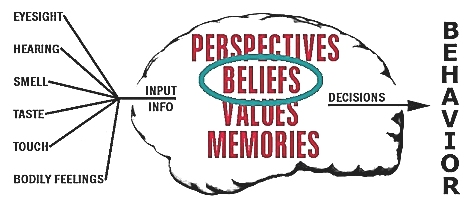
Internalized values
are the roots of human goals and preferences. They have to do with the
way a person would like things to be. Each human has many values, and
they sometimes conflict. Depending on circumstances, one value will take
priority over another. Eating supper at 6:00 P.M. may be one of your values,
but it is not apt to be the controlling value if your house happens to
be on fire at that hour. Values are arranged in a constantly shifting
hierarchy of priority. People always do what they think is best, and that
"best" is determined by how their hierarchy of internalized
values interacts with the brain/mind's assessment of past, present, and
anticipated future circumstances.

Some values, such as bodily survival, territoriality, and sexual reproduction,
appear to be hardwired into the instinctive/reactive process. And some
part of the brain appears to come preprogrammed with certain ethical values
such as the Golden Rule, the incest taboo, and other values of conscience.
But the neocortex-based intellectual and intuitive processes use a hierarchy
of learned, internalized, inherently changeable values to evaluate situations,
make decisions, and initiate behaviors. One or more of these brain processes,
together with its hierarchy of values, is always in charge of our lives.
Roger Sperry commented
on this situation and some of its broader implications:
Human values, in
addition to their commonly recognized significance from a personal,
religious, or philosophic standpoint, can also be viewed objectively
as universal determinants in all human decision making. All decisions
boil down to a choice among alternatives of what is most valued, for
whatever reasons, and are determined by the particular value system
that prevails. Human value priorities, viewed thus in objective control-system
theory, stand out as the most strategically powerful causal control
now shaping world events. More than any other causal system with which
science now concerns itself, it is variables in human value systems
that will determine the future.1
If we don't like
the values we have internalized to date or the particular mental process
that is calling the shots, then we must change things. By being selective
about the influences we expose ourselves to and the mental habits we develop,
we can influence the mix and relative priority of our internalized values
— as well as which of the three brain-mind processes is in control.
The ancient brain structures may be pretty much hardwired, but the neocortex
is not. Positive influences lead to positive mind habits. This, in turn,
results in the brain's vast network of neural connections rearranging
themselves in ways that allow us to minimize and transcend those mental
flaws. I call the process wisdom development, and to explore this
further you might want to visit The Wisdom Page website at www.wisdompage.com.
Also of possible interest is the 22-minute illustrated video
that covers the same territory as this essay.
References
1. Sperry, R.W. "Bridging
science and values: A unifying view of mind and brain." American
Psychologist: April, 1977, p. 237.